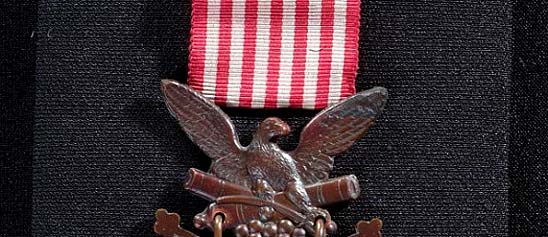Physical DescriptionKhaki-colored tropical worsted material with a rolled collar with lapels, epaulets on the shoulders, two false horizontal breast pockets with small gold-colored metallic buttons, and two side pockets over the hips.
- Description
-
Physical Description
-
Khaki-colored tropical worsted material with a rolled collar with lapels, epaulets on the shoulders, two false horizontal breast pockets with small gold-colored metallic buttons, and two side pockets over the hips. The jacket is closed by four gold-colored metallic buttons. Staff sergeant chevrons are on the upper arm of both sleeves above the elbow, the Eighth Army Air Force patch is on the left shoulder, and four overseas bars indicate two years' service overseas. All buttons have the Great Seal of the United States on the front. The collar disk on the right lapel contains the letters "U.S." denoting United States; the collar disk on the left lapel contains the wings and propeller blade of an enlisted member of the Army Air Forces. Both disks are made from gold-colored metal. Ribbons over the left breast pocket represent the Army Good Conduct Medal, the Women's Army Corps Service Medal, and the European-African-Middle Eastern Campaign Medal.
-
Specific History
-
This jacket was worn by Staff Sergeant Margaret C. Frank, WAC, who was assigned to the Eighth Air Force in England as a telephone operator from 1943 to 1945.
-
General History
-
During World War II over 150,000 women served in the Women's Army Auxiliary Corps (WAAC) or Women's Army Corps (WAC). Special legislation was required before the women could serve in the army. The law authorizing the WAAC was signed by President Franklin Roosevelt in May 1942 and the first WAACs began training in July 1942. Initially WAACs were only assigned to duties in the continental United States. However, when General Dwight Eisenhower requested trained secretarial, clerical, and administrative personnel, a WAAC detachment was sent to his headquarters in North Africa in early 1943. A WAAC battalion was sent to England in spring 1943 to provide similar expertise to army and air forces units gathering for the invasion of Europe.
-
The status of the WAAC as an auxiliary, serving with but not in the army, was confusing and made many routine activities difficult. In mid-1943, Congress authorized the Women's Army Corps as a full-fledged army organization. All WAACs were either converted to WAC status or discharged. Women served in many jobs in addition to the secretarial, clerical, and administrative fields. They were assigned as drivers, mechanics, cooks, ordnance specialists, and radio operators; they worked in communications, logistics, public affairs, medical, intelligence, and many other specialties. They served in the United States and in all overseas theaters. Because of their exemplary record, women were made a part of the regular military establishment in 1948.
- associated date
-
1941 - 1945
- user
-
Frank, Margaret C.
- ID Number
-
AF.79105M
- designer number
-
PQD 426
-
55-J-569-243
- accession number
-
317886
- catalog number
-
79105M
